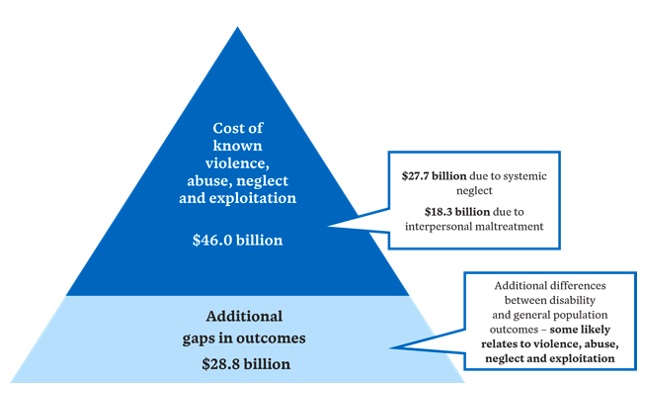
Actuaries contribute to the work of the Disability Royal Commission
Systemic failures and maltreatment experienced by people with a disability in Australia is estimated at $46 billion annually or $9,600 on average per person with a disability. These are among the key findings of recently published research undertaken by Taylor Fry in collaboration with The Centre for International Economics.
The Royal Commission into Violence, Abuse, Neglect and Exploitation of People with Disability has been running since 2019. It has the mammoth task of sifting through evidence and making recommendations to help address the maltreatment of people with disability across a wide range of contexts. Involving 32 public hearings and thousands of pieces of evidence so far, it is a comprehensive study of the lived experience of people with disability.
In addition to evidence collection, the Royal Commission comprises a research stream. Taylor Fry, in partnership with The Centre for International Economics, recently contributed to the Royal Commission through a research report looking at the economic cost of violence, abuse, neglect and exploitation of people with disability. The report, led by Taylor Fry Principal Dr Hugh Miller, underscores the need for urgent action to address the many cases of identified by the Royal Commission through its inquiry. It aims to contribute to a growing awareness across government and in the community of the costs of such maltreatment of people with disability and the societal inequities they face daily.
With 4.8 million people living with disability in Australia (19% of the total population) and half of this figure over the age of 65, we hope our work will provide impetus to decision-makers and policy-makers in determining allocation of resources across areas of governmental intervention to address the issue.
Why estimate economic costs?
While the Royal Commission has collected a large amount of evidence around maltreatment, it is hard to appreciate the scale of this through public hearings and other submissions. An economic costing allows different sources of evidence to be brought together to gain a realistic picture of violence, abuse, neglect and exploitation. Adding the economic lens of costs in turn allows the impact to be compared against similar issues and the cost of various potential interventions.
How we estimate the economic costs
Using actuarial and econometric modelling to estimate the cost, we calculate the expenditure and non-market costs that would be avoided if violence, abuse, neglect and exploitation ceased. This is based on a range of statistics available and then expressed in terms of the 2021-22 financial year. The costing takes into account:
- Systemic failures and neglect ($27.7 billion) – This includes failure by government, business and other systems to provide equal opportunity to participate in the economy and equal access to quality services. Costs include loss in labour force productivity and costs associated with lack of accessible housing.
- Interpersonal maltreatment perpetrated by individuals ($18.3 billion) – Costs include additional hospital stays due to maltreatment and reduced quality of life.
These costs are estimated across a framework that covers five broad domains: Health and Wellbeing, Employment and Financial Security, Inclusive Homes and Communities, Safety, Rights and Justice, and finally Education and Learning. A broad range of outcomes is fitting for the work, since maltreatment impacts many aspects of people’s lives.
Key findings – Cost, experience and gaps in outcomes
Some of the research highlights include:
- The cost of violence, abuse, neglect and exploitation that can be reliably measured is $46 billion in 2021-22;
- 60% of people living with disability experienced maltreatment perpetrated by an adult;
- 28% of children with disability experienced significant child peer bullying in their lifetime;
- the average cost of violence, abuse, neglect and exploitation per person is double for First Nations people;
- the cost of interpersonal maltreatment is higher for women than men, while the cost of systemic failures is higher for men.
Gaps in outcomes, which are indicative costs from other forms of over-representation in poor-outcome areas and under-representation in financial and social opportunities, are valued at $28.8 billion in 2021-22. Specifically, these include:
- Finding it more difficult to secure employment when a person with disability rates themselves as ‘able to work’;
- poor health outcomes from higher rates of obesity, lower rates of physical activity and higher blood pressure compared to other Australians;
- higher rates of homelessness, involvement with the justice system and loneliness.

The report also states that costs would likely be higher if more data was available. Substantial savings can be made over time if governments and society are successful in addressing maltreatment, including issues of systemic failure and neglect.
How the report will be used
We hope our findings will assist decision-makers to allocate resources and inform interventions. The Royal Commission is ongoing, and the work includes making recommendations around ways to reduce the occurrence and impact of maltreatment for people with disability.
This is an expanded version of this article, which first appeared on the Taylor Fry website.
CPD: Actuaries Institute Members can claim two CPD points for every hour of reading articles on Actuaries Digital.






